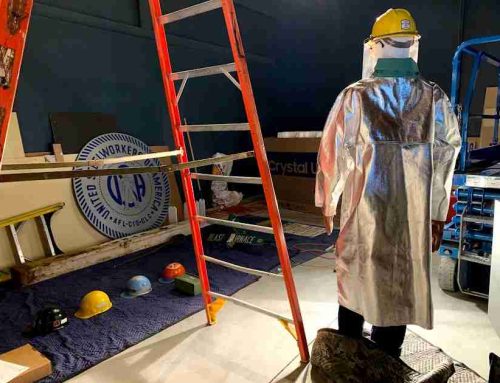
We at the Baltimore Museum of Industry (BMI) are proud to unveil this blog, which will provide behind-the-scenes insights into our Bethlehem Steel Legacy Project (BSLP). Announced in late January, this multi-year initiative will include several different elements. One major goal is to create a permanent exhibition at the museum in 2021. Members of the BMI team are already hard at work, however, conducting research on existing projects, meeting with residents and local organizations, organizing archival materials, and planning events focused on Bethlehem Steel. This project is made possible through funding from Tradepoint Atlantic, the company that owns the former site of the Bethlehem Sparrows Point steel mill.

Workers on the electrolytic tinning line at the Bethlehem Steel Sparrows Point plant, January 1958, from the BG&E Print and Negative Collection at the Baltimore Museum of Industry
For a region so often associated with steelmaking and shaped by deindustrialization, it seems surprising to visitors and staff alike that the Bethlehem Steel story isn’t already told in great detail at the BMI. We have often heard from visitors that this is a missing link in our interpretation of industrial history in Maryland. I believe I speak for many at the museum when I say that it’s exhilarating to be a part of this long-overdue effort to preserve and share the stories of the individuals who worked in this industry as well as explore the impact this industry had on our city.
Inspired by the Museum as Site for Social Action (MASS Action) movement, which seeks to align museums with more equitable and inclusive practices, the BMI’s senior staff members outlined five project values that will define our work on BSLP:
- Transparency: We will communicate openly and proactively with museum staff, project stakeholders, community members, and the public
- Inclusion: We will strive to ensure that all staff members feel invested in the project, that they participate meaningfully, and their they are aware of the project’s progress.
- Authenticity: We will partner with communities outside the museum. We will work with members of the Sparrows Point community and help to convey their experience truthfully and with compassion. When we ask for feedback, we are prepared to take it seriously and act on it.
- Uncertainty: We acknowledge that we don’t know exactly what final product will come from this engagement and we are comfortable with an iterative process that may at times feel ambiguous.
- Integrity: We will ensure that all phases of this project remain true to the museum’s mission and vision.

1973 view of the Bethlehem Steel Plant in Sparrows Point from across the Patapsco River, from the BG&E Print and Negative Collection.
In addition, staff have outlined several objectives to guide this project:
- To complicate the mythology around Bethlehem Steel – not to present a sanitized version of history through rose-colored glasses
- To highlight the voices of women, people of color, and younger people
- To tie into pressing contemporary issues related to work, including unemployment, displacement, and opportunity
- To make explicit the connections between the past and present
- To take an interdisciplinary approach to this subject
- To establish and nurture sustained, long-term investment in this topic rather than a one-off exhibit or program
- To gather feedback from visitors that will inform a permanent exhibition on Bethlehem Steel
Don’t expect to find extremely polished, academic-style essays here. This blog is designed to share the work that takes place behind the scenes in a museum—warts and all. We plan to experiment with formats and invite many different team members to contribute in an effort to create timely, relevant, and personal posts.
I anticipate that people with personal experience of or professional interest in the topic of Bethlehem Steel, aspiring and emerging museum professionals seeking a better understanding of the field, and Baltimore-area residents who want to learn more about the project before or after visiting the museum will find this blog most illuminating. I look forward to hearing from you, readers, and gaining a better understanding of your goals and hopes for this project.
Author Bio:



